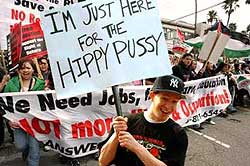After the first two murders were discovered at 7:15 a.m., campus police chief W.R. Flinchum said he assumed the killer had left the campus and perhaps even the state. Flinchum and university president Charles Steger didn't lock down the campus and assure everyone else's safety. One has to wonder why Blacksburg police chief Kimberly Crannis wasn't immediately notified either.
This nonchalance allowed the gunman -- who had his own dorm room on campus -- TWO FULL HOURS of "time to reload, restock his ammunition supply and walk across campus calmly to Norris Hall, where he chained all the doors shut and began systematically killing as many people as he could," writes Joseph Farah of WorldNetDaily.com. Thirty people would not have been slaughtered if the police had evacuated the campus right away. Instead, the authorities -- the campus police chief, the city police chief, and the university president -- took their time. Instead of taking bold action, the university decided to send emails advising students to be "cautious."
When the Norris Hall shootings began at 9:15 a.m., there were no police around the building, and no alert to all students broadcast.
Thirty minutes later, at 9:45 a.m., campus police received a cell phone call from inside Norris Hall. It took a few more minutes for officers to get there and a few more minutes to break in, but by then the shooting had stopped. Cho killed himself last.
Consider that if the campus police had put everyone on a REAL red alert, police officers would have been around and inside every building on campus. They could have stopped Cho, who had belts of ammunition strapped across his chest, from entering Norris Hall in the first place. They could have stormed the building early and saved most of the 30 people who otherwise died.
Now you might be thinking that I am "Monday Morning quarterbacking". But the precedent for how to deal with deranged murderers was already there: The 1999 massacre at Columbine High School in Littleton, Colorado. Columbine was a wake-up call to many law-enforcement agencies across America. The old style of dealing with a shooter in a building full of people was to close off the perimeter and try to negotiate. But that no longer works in our world of murder plus suicide.
The Virginia Tech and Blacksburg, Virginia police chiefs that didn't recommend locking down the campus and didn't station officers around buildings were apparently operating in a pre-Columbine world. They were out-of-touch with what other police departments had learned. After Columbine in 1999, many police departments had retrained themselves to "shoot to kill" urban terrorists. As Timothy Harper wrote in 2000 in his eye-opening Atlantic Monthly article Shoot to Kill:
"Officers were traditionally trained to help the wounded and evacuate bystanders. Now they are taught to step over the wounded, push bystanders aside, and keep pursuing the shooters. In the past SWAT marksmen were expected to put a
shooter down. Now every officer is instructed to 'take the shot if you have it.'"











No comments:
Post a Comment